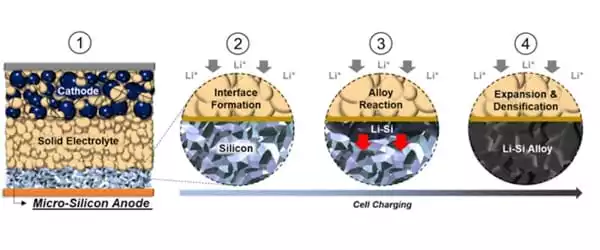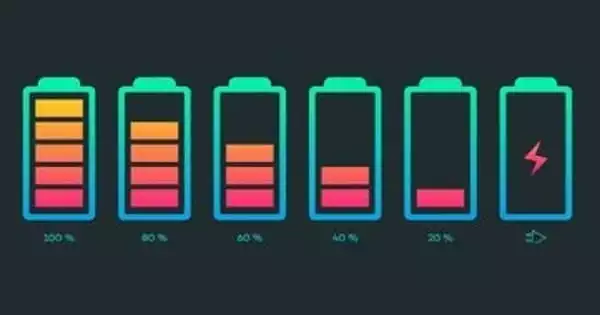Engineers developed a new type of battery by combining two promising battery sub-fields into a single battery. The battery incorporates a solid-state electrolyte as well as an all-silicon anode, resulting in a silicon all-solid-state battery. Initial tests show that the new battery is safe, long-lasting, and energy-dense. It has the potential to be used in a wide range of applications, from grid storage to electric vehicles.
The battery technology is described in the current issue of Science. The study was led by nano engineers from the University of California, San Diego, in collaboration with researchers from LG Energy Solution.
Silicon anodes are well-known for their high energy density, which is ten times that of graphite anodes, which are commonly used in today’s commercial lithium-ion batteries. Silicon anodes, on the other hand, are notorious for their ability to expand and contract as the battery charges and discharges, as well as for degrading in the presence of liquid electrolytes. Despite the tantalizing energy density, these challenges have kept all-silicon anodes out of commercial lithium-ion batteries. The new study, published in Science, shows that using the right electrolyte can pave the way forward for all-silicon anodes.
“With this battery configuration, we are breaking new ground for solid-state batteries using alloy anodes like silicon,” said Darren H. S. Tan, the paper’s lead author. He recently completed his Ph.D. in chemical engineering at the University of California, San Diego Jacobs School of Engineering and co-founded UNIGRID Battery, which has licensed this technology.
Engineers created a new type of battery that weaves two promising battery sub-fields into a single battery. The battery uses both a solid state electrolyte and an all-silicon anode, making it a silicon all-solid-state battery.
Metallic lithium has always been used as an anode in next-generation solid-state batteries with high energy densities. However, this limits battery charge rates and necessitates an elevated temperature (typically 60 degrees Celsius or higher) during charging. The silicon anode overcomes these constraints, enabling much faster charge rates at room to low temperatures while maintaining high energy densities.
The team demonstrated a laboratory scale full cell with 500 charge and discharge cycles and 80 percent capacity retention at room temperature, which represents significant progress for both the silicon anode and solid state battery communities.

Silicon as an anode to replace graphite
Silicon anodes are, of course, not new. For decades, scientists and battery manufacturers have looked to silicon as an energy-dense material that could be mixed into, or completely replace, traditional graphite anodes in lithium-ion batteries. In theory, silicon has roughly ten times the storage capacity of graphite. However, in practice, lithium-ion batteries with silicon added to the anode to increase energy density typically suffer from real-world performance issues: specifically, the number of times the battery can be charged and discharged while maintaining performance is insufficient.
The interaction between silicon anodes and the liquid electrolytes with which they have been paired is responsible for much of the problem. The problem is exacerbated by the large volume expansion of silicon particles during charge and discharge. As a result, severe capacity losses occur over time.
“It is critical for battery researchers to address the system’s underlying issues. We know that one of the major issues with silicon anodes is liquid electrolyte interface instability “Shirley Meng, UC San Diego nanoengineering professor and director of the Institute for Materials Discovery and Design, was the corresponding author on the Science paper. “We needed a completely different approach,” Meng explained.
Indeed, the UC San Diego-led team took a different approach, removing the carbon and binders associated with all-silicon anodes. Furthermore, the researchers used micro-silicon, which is less processed and less expensive than the more commonly used nano-silicon.
An all solid-state solution
The team not only removed all of the carbon and binders from the anode, but they also removed the liquid electrolyte. Instead, they used a solid electrolyte based on sulfide. In batteries with all-silicon anodes, their experiments revealed that this solid electrolyte is extremely stable.
“This new work offers a promising solution to the silicon anode problem, though more work remains to be done,” said professor Meng. “I see this project as validation of our approach to battery research here at UC San Diego.” We combine the most rigorous theoretical and experimental work with creativity and thinking outside the box. We also understand how to collaborate with industry partners while pursuing difficult fundamental challenges.”
Efforts to commercialize silicon alloy anodes in the past have primarily focused on silicon-graphite composites or the combination of nano-structured particles with polymeric binders. However, they continue to struggle with insecurity. By replacing the liquid electrolyte with a solid electrolyte and removing the carbon and binders from the silicon anode, the researchers avoided a series of related issues that occur when anodes become soaked in the organic liquid electrolyte as the battery functions.
Simultaneously, by removing the carbon from the anode, the team significantly reduced the interfacial contact (and unwanted side reactions) with the solid electrolyte, avoiding the continuous capacity loss that is typical of liquid-based electrolytes. This two-part move enabled the researchers to fully reap the benefits of silicon’s low cost, high energy, and environmentally friendly properties.
Impact & Spin-off Commercialization
“Many limitations of conventional batteries are overcome by the solid-state silicon approach. It provides us with exciting opportunities to meet market demands for higher volumetric energy, lower costs, and safer batteries, particularly for grid energy storage “Darren H. S. Tan, the paper’s first author, explained.
Sulfide-based solid electrolytes were once thought to be extremely unstable. However, this was based on traditional thermodynamic interpretations used in liquid electrolyte systems, which did not account for solid electrolytes’ excellent kinetic stability. The team saw an opportunity to use this seemingly contradictory property to create a highly stable anode. Tan is the CEO and cofounder of UNIGRID Battery, a startup that has licensed the technology for these silicon all solid-state batteries.
Parallel to this, fundamental research at UCSan Diego will continue, including additional research collaboration with LG Energy Solution. “LG Energy Solution is delighted that the latest research on battery technology with UC San Diego was published in Science, a significant acknowledgement,” said Myung-hwan Kim, President and Chief Procurement Officer at LG Energy Solution. “With this latest discovery, LG Energy Solution is one step closer to realizing all-solid-state battery techniques, which would vastly expand our battery product lineup.”
“As a leading battery manufacturer, LGES will continue to foster cutting-edge techniques in next-generation battery cell research,” Kim added. LG Energy Solution announced plans to expand its collaboration with UC San Diego on solid-state battery research.
The study was funded by LG Energy Solution’s open innovation program, which actively promotes battery-related research. LGES has been collaborating with researchers all over the world to develop related techniques.














